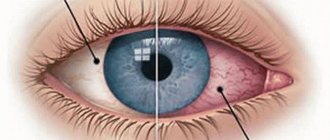Tonsillitis is a disease that is accompanied by inflammation of the tonsils. The development of the disease is influenced by microorganisms that enter the body through airborne droplets. Chronic is characterized by constant relapses, reduced immunity of the tonsils and constant inflammatory processes. Treatment takes an integrated approach; it is important not only to get rid of the manifestations of the pathology, but also to eliminate the underlying factor. In children, the disease is simpler than in adults, so it is important to know how to treat this disease.
Chronic tonsillitis: what is it?
Exacerbation of tonsillitis occurs against the background of any infection of the nasopharynx. Hypothermia, vitamin deficiency, and allergic conditions can be a provoking factor.
The word tonsillitis is translated from Latin as tonsil glands. The surface of these glands is inhabited by beneficial microorganisms that protect the throat from the penetration of foreign pathogens. If the self-cleaning process is disrupted, inflammation develops. The tonsils enlarge, cause pain, the temperature rises, and other symptoms of intoxication appear.
The tonsils are paired structures that are located in the throat. They resemble a small oval in shape, about 5 mm in size. Tonsils consist of lymphoid tissue and perform a protective function.
Chronic tonsillitis is a disease of infectious origin. The inflammatory focus periodically occurs in the tonsils. Microbes, under favorable conditions, enhance their growth and reproduction. During the period of exacerbation of chronic tonsillitis, a person is considered contagious; the infection is most often transmitted by airborne droplets.
What it is?
This is inflammation of one or more tonsils (often palatine tonsils). Tonsils are lymphatic immune organs that protect the respiratory tract from viruses and bacteria. But the tonsils themselves can become infected, causing pain and other symptoms.
Quite interesting is the form of tonsillitis, which can be acute or chronic:
- The acute form may result from an exacerbation of chronic tonsillitis under the influence of overwork, hypothermia or reduced immunity.
- Chronic tonsillitis is a consequence of an acute form that was poorly treated or not treated at all.
Types of tonsillitis:
- Infectious: bacterial, viral, fungal.
- Simple – local symptoms.
- Toxic-allergic – changes in the functioning of the heart, lymphadenitis and other complications.
- Compensated – the infection is present, but the disease does not develop.
- Decompensated – manifestation of all symptoms of angina and other systems.
Types of inflammation:
- Catarrhal;
- Purulent;
- Phlegmonous.
According to the development mechanism there are:
- Primary tonsillitis - the development of an independent disease;
- Secondary tonsillitis is the development as a result of another disease.
Other types of tonsillitis:
- Angranulocytic;
- Monocyte;
- Follicular;
- Lacunar;
- Fibrinous;
- Herpetic;
- Ulcerative-necrotic.
- Mixed.
Causes
The following diseases are considered to be the causes of tonsillitis:
- decreased immunity as a result of infectious diseases (scarlet fever, influenza, measles);
- pathological processes in the ENT organs: sinusitis, otitis media, adenoids;
- diseases of the oral cavity (for example, caries, stomatitis);
- The hereditary factor plays an important role.
A decrease in local and general immunity can occur as a result of poor nutrition, bad habits, unfavorable environmental conditions, overwork and frequent stress.
Causes
Acute tonsillitis is caused by various pathogens, which include streptococci, staphylococci, adenoviruses and other pathogenic bacteria and viruses. At the same time, some of their copies are present in the oral cavity of a healthy person, who may not get a sore throat, but is not safe for people with destabilized immunity.
The disease may be favored by factors such as:
- decreased immunity;
- hypothermia;
- damage to the tonsil glands due to injury;
- protracted inflammatory and infectious processes of the pharynx cavity and sinuses;
- foci of infection in adjacent organs, for example, diseases of the teeth and gums, adenoids, etc.
Often, the “first sign” of acute tonsillitis is the experience of an acute respiratory infection, the pathogens of which nullify the protective functions of the superficial tissue of the tonsils and cause the penetration of bacteria.
The development of pathology may also be based on an allergic component: allergies can both provoke the disease and contribute to its progression.
Forms of the disease
Acute tonsillitis has several forms. The mildest course is the catarrhal form of tonsillitis, and the most severe is the necrotic form of the disease. There are also follicular and lacunar tonsillitis.
Chronic tonsillitis is spoken of when the symptoms of the disease return with any hypothermia or do not go away at all, but only reduce their intensity.
In medicine, the following types of tonsillitis are distinguished:
- Compensated tonsillitis is accompanied by an exacerbation of local manifestations. I am worried about a sore throat of varying intensity, the temperature periodically rises, the throat is constantly red, the lymph nodes in the neck are always enlarged.
- Decompensated tonsillitis is characterized by the appearance of purulent foci. The consequences of the inflammatory process disrupt the functioning of other organs. Problems with the kidneys, heart, and skin diseases may develop. Tinnitus and dizziness begin to bother me.
Depending on the severity of tonsillitis, mild, moderate and severe forms are also distinguished. The severity is determined by the patient’s general well-being and the severity of symptoms.
Treatment methods
There are two methods of treating tonsillitis. The first of them is surgical intervention (tonsillectomy), and the second is medication. The first method is most often used, since removing the tonsils can very quickly relieve the patient from chronic tonsillitis. Many doctors find it easier to perform a tonsillectomy than to conduct a fairly long course of drug treatment.
It should be remembered that in the absence of tonsils, the body becomes susceptible to various kinds of infectious diseases (bronchitis, laryngitis, pharyngitis, and so on).
Surgical intervention should be resorted to only when treatment of tonsillitis with a conservative method has proven ineffective. Indications for tonsillectomy are frequent sore throats, complications, problems with the kidneys, heart, blood vessels and other organs.
Medical or conservative treatment includes a wide range of medications. Next, we will consider the types of drug treatment for tonsillitis.
Antiviral
If tonsillitis is viral in nature, then the tonsils become swollen and red, but there is no plaque on their surface. To treat a viral infection, the following antiviral drugs will be required:
Suitable medications for children include:
Antibiotics
Antibacterial therapy is prescribed when the disease is caused by a bacterial infection (most often streptococci).
- Antibiotics of the penicillin group (Amoxiclav, Amoxicillin). They have a targeted effect and do not affect the intestinal microflora. Currently, many bacteria are resistant to penicillin, so doctors prescribe a semi-synthetic version of antibiotics.
- Antibiotics of the cephalosporin group (Cefpodoxime, Cephalexin). They are prescribed for penicillin intolerance. But unlike the previous group, their action is not so narrowly targeted, and their use can negatively affect the intestinal microflora. Cephalosporins practically do not cause allergies.
- Antibiotics of the macrolide group (Erythromycin, Josamycin). Macrolides are used to treat purulent tonsillitis. They are the safest antibiotics and are better tolerated by the body. But bacteria quickly become resistant to them.
Antibiotics of the tetracycline group and sulfonamides are not effective for the treatment of tonsillitis, since streptococci are resistant to them. Based on this, we can conclude that only a specialist should prescribe these drugs and select their dosage.
Antibiotics are usually taken for seven or ten days. The effect occurs already in the first days of use, but interrupting the course of therapy is unacceptable, since the disease may return again.
Anti-inflammatory
Nonsteroidal anti-inflammatory drugs are necessary to eliminate pain and speed up recovery after tonsillitis. The following medications are prescribed to relieve inflammation:
They allow you to speed up the recovery processes in the glandular and connective tissue of the tonsils.
Symptomatic
Powders
Most often, a drug in powder form such as Streptocide is prescribed for the treatment of tonsillitis. It is taken three to six times a day. The course of treatment lasts from five to seven days. When taking Streptocide, it is necessary to increase the volume of fluid consumed, since the drug is excreted through the kidneys.
The drug can be used as a powder for sore tonsils. The powder should be left on the surface of the tonsils for ten minutes, and then gargle with a disinfectant solution. The treatment is repeated every two hours.
Streptocide is also suitable for gargling. To do this, the powder is dissolved in warm water, the temperature of which is approximately forty degrees.
The drug has a bitter taste, so you can mix it with honey. Take one teaspoon of this mixture in the morning and evening. In this case, you should keep Streptocide with honey in your mouth for as long as possible.
Also, cold and flu powders can be used as an antipyretic at high temperatures.
First signs
The first signs of tonsillitis are a rise in body temperature, muscle, joint, and headaches. The patient feels general malaise, weakness, and drowsiness.
When examining the throat, a doctor can easily make the correct diagnosis, knowing what tonsillitis looks like. Tonsillitis can be suspected by the external signs of the tonsils:
- tonsils look loose and compacted;
- there is a white-gray coating on the tonsils, there may be a clot of pus;
- swollen uvula in the larynx;
- the size of the tonsils is increased;
- severe redness of the entire throat;
- the chronic process is indicated by scars and adhesions on the larynx;
- cervical lymph nodes are enlarged and painful to the touch.
If you independently detect one of the listed symptoms, you need to seek the help of a specialist in order to begin proper treatment and prevent complications.
Preparations for prevention
To maintain the body's immune strength or to recover after an illness, you can take multivitamins, for example, Multitabs, Vitrum or Complivit. It is also recommended to take dietary supplements that contain natural substances that are immunostimulants, for example, eleutherococcus or ginseng.
You should regularly rinse and moisturize the nasal cavity with special solutions containing sea salt, for example, Aquamaris drops. During periods of widespread incidence of colds and flu, you can take medications to stimulate the immune system. This group includes drugs such as IRS-19, Interferon and others.
Vaccine Influvac for the prevention of influenza
What is the name of the disease associated with inflammation of the middle ear and methods of its treatment can be found in this article.
Symptoms of chronic tonsillitis, photo of the throat in an adult
Chronic sore throat can be recognized by the following symptoms:
- worries about sore and sore throat;
- cough;
- increased body temperature, often in the evening;
- weakness, irritability;
- there is a disturbance in heart rhythm and breathing;
- A white coating appears on the tongue and throat, and purulent formations can be found on the tonsils.
Additionally, the patient may experience pain and aches throughout the body. The functioning of the cardiac and genitourinary systems is disrupted, and an allergic rash can be found on the skin that cannot be treated.
See also
Symptoms and treatment of sore throat in children at home
Read
During the period of subsidence of the disease, the symptoms also persist, but reduce their intensity. There is discomfort in the throat, pain may only bother you in the morning, and small purulent accumulations can be observed on the tonsils.
Symptoms
During the period of remission, “chronic tonsillitis” may practically not reveal itself at all. Some patients complain of:
- slight sore throat;
- swelling and redness of the tonsils;
- expansion of lacunae and the appearance of purulent discharge in them (can only be seen by an ENT doctor);
- hoarseness of voice;
- bad breath;
- feeling of warmth in the tonsils;
- difficulty swallowing;
- enlargement of submandibular nodes.
When the disease worsens, the patient's body is poisoned by toxins released during purulent inflammation. Symptoms of chronic tonsillitis during exacerbation include:
- severe fatigue, weakness;
- severe sore throat;
- chronic fatigue, which manifests itself in the morning;
- deterioration in performance, weakening of attention;
- insomnia or, conversely, drowsiness;
- lack of appetite;
- low-grade fever;
- temperature rise to high values;
- dark circles under the eyes.
Lymph nodes in chronic tonsillitis during an exacerbation are almost always significantly enlarged.
But coughing is not typical for this disease. Cough with chronic tonsillitis occurs only if the inflammatory process descends below the tonsils. In this case, laryngitis may occur, affecting the larynx and accompanied by a severe cough. Or bronchitis.
What are the dangers of frequent exacerbations?
Immunity is reduced due to such unfavorable factors as stress, hypothermia, chronic fatigue, unbalanced nutrition, infectious diseases, and taking drugs that suppress the immune system. As a result, chronic tonsillitis worsens again.
One of the severe complications of chronic tonsillitis is the development of an abscess. Treatment is carried out in a hospital under the supervision of doctors. First, the body temperature rises, the tonsils swell and enlarge, and the throat hurts. Gradually, the intensity of all manifestations increases, the patient finds it difficult to swallow saliva and food, sleep is disturbed, and appetite decreases. It becomes difficult to open your mouth due to increased tone of the jaw muscles.
Chronic tonsillitis also poses a danger to other internal organs. The consequences of tonsillitis are:
- arthritis, lupus erythematosus, rheumatism, scleroderma;
- skin diseases appear: psoriasis, neurodermatitis, dermatitis;
- diseases of the organs of vision;
- pathological processes in the kidneys;
- reproductive function suffers;
- damage to the nervous system;
- hemorrhagic vasculitis.
To prevent complications, you need to seek help from a specialist in time, who will prescribe the correct treatment and select the appropriate dosage of medications.
Complications
If a sore throat is not treated, then it will cause complications. Moreover, they are very different, and we will consider the most common ones. The disease can affect various organs, and not all consequences are reversible.
What are the complications:
- Otitis, bronchitis and pharyngitis.
- Rheumatism of the joints and heart.
- Kidney diseases, such as pyelonephritis or glomerulonephritis.
- Appendicitis.
- Sepsis.
If a person experiences blood poisoning, which is possible if the infection lasts for a long time, then the consequences will be extremely negative. Even death is possible in advanced cases. To avoid complications, it is enough to start therapy in a timely manner.
Under the supervision of a doctor, you can begin to recover after just five days. On average, treatment lasts up to two weeks. But it is worth remembering that each case is individual, so it is impossible to say for sure how quickly a person will recover.
Diagnostics
Laboratory diagnostics allows us to determine the form of tonsillitis, the stage of its development and the degree of spread of the infection. Treatment is carried out by an otolaryngologist, an infectious disease specialist, and if other organs are involved in the pathological process, then by specialized specialists. Diagnostic methods:
- Pharyngoscopy involves a visual examination of the condition of the tonsils using special medical instruments.
- You definitely need to take a blood test. During the acute course of the disease, the entire leukocyte count increases. With tonsillitis in the chronic stage, one indicator increases.
- Bacterial culture of discharge from the tonsils makes it possible to determine the pathogen and their sensitivity to certain groups of antibiotics.
Loosening, redness, the presence of purulent accumulations, adhesions and scars can be found on the mucous membrane of the tonsils. During an exacerbation, the throat appears swollen, inflamed, red, the tonsils become enlarged, and a white or gray coating is present. Impaired nasal breathing only worsens the patient’s general well-being.
Reasons for appearance
Sore throat becomes chronic if the infection remains in the body for a long period of time and is not treated properly.
Factors of occurrence:
- Decreased human immunity
- Untimely, ineffective treatment
- Complication of breathing through the nose
- Infections of the mucous epithelium of the gums, oropharynx (caries, stomatitis, adenoids, sinusitis, pharyngitis)
- Hypothermia of the body
It must be remembered that with excessive use of antibiotics, bacteria become resistant to the components of the drugs. Treatment for sore throat continues, but does not produce an effect, as a result of which the disease becomes chronic and can worsen from time to time.
Treatment of chronic tonsillitis in adults
There are many ways to treat tonsillitis in an adult. These could be various groups of medications, physiotherapy courses, or traditional medicine compounds. In severe cases, surgery is performed.
It is difficult, but possible, to cure chronic tonsillitis forever. On days of exacerbation, it is necessary to carry out correct and complete antibacterial therapy. Such treatment, carried out regularly during the onset of a sore throat, will help get rid of the inflammatory focus in the tonsils.
Among the antibiotics, Azithromycin, Klacid, Flemoxin, Amoxiclav, Ceftriaxone are often prescribed. Antihistamines, for example, Zyrtec, Loratadine, Suprastin, help reduce the area of swelling and inflammation in the throat. If you experience severe pain, you cannot do without painkillers.
Any therapy should be accompanied by the intake of vitamin-mineral complexes and immunomodulators. They will help get rid of the acute course of tonsillitis and prolong the period of remission.
If this does not help restore the functioning of the tonsils, they have to be removed. There are other indications for surgery.
Local remedies and preparations for adults
Therapeutic therapy is not complete without the use of local medications that will help get rid of tonsillitis forever. Gargling, lubricating and rinsing the throat with solutions is effective. Preparations:
- For chronic tonsillitis, gargling is carried out with anti-inflammatory drugs such as Miramistin, Rotokan, Furacilin, Chlorhexidine. They are prescribed by a doctor. Herbal decoctions and infusions help.
- Sprays for treating the throat and tablets intended for resorption: Hexoral, Kameton, Bioparox, Stopangin, Grammidin, Strepsils.
- Lubricating the tonsils with an oil solution of Chlorophyllipt, Iodinol, Lugol, Collargol is effective.
The duration of treatment is determined by the doctor and in most cases is 7–8 days.
Treatment of tonsillitis
Acute viral tonsillitis. If inflammation of the tonsils is caused by a common ARVI, then treatment in adults is carried out as follows:
- Drink plenty of fluids, predominantly a dairy-vegetable diet, rest.
- Frequent rinsing with decoctions of anti-inflammatory herbs and antiseptic solutions. Usually these are rivanol, chlorhexidine, iodinol, decoctions of sage, calendula, chamomile.
- Resorption of tablets (lozenges) with anti-inflammatory and antiseptic effects: lisobakt, lizak (active ingredient - lysozyme), strepsils, travesil and others.
- Antibacterial agents for viral sore throat are prescribed in cases where a secondary infection has occurred.
- If the temperature rises above 38.50C, take antipyretics. In this case, preference is given to drugs that contain paracetamol or ibuprofen (Nurofen). It is strictly forbidden to give aspirin to children as a medicine to reduce fever. If the temperature remains high, then the doctor may prescribe nimesulide (nimesil, nimegesik) to adult patients and children over 12 years of age, and at a younger age - analgin with diphenhydramine or its analogues.
Acute bacterial tonsillitis. The same drugs are used as for viral tonsillitis, and mandatory treatment with antibiotics is also carried out, which are selected based on the sensitivity of the specific pathogen.
Among the means of antibacterial therapy, doctors most often prescribe:
- amoxicillin with clavulonic acid (augmentin, amoxiclav, flemoclav and others);
- cephalosporins (cephalexin, ceftriaxone);
- macrolides (azithromycin, clarithromycin);
- fluoroquinolones (ciprofloxacin, ciprolet).
Antibiotics can be prescribed either orally or by injection. Often, treatment of tonsillitis in children is carried out with protected amoxicillins, cephalosporins and macrolides.
Acute tonsillitis caused by a fungal infection. Treatment of tonsillitis caused by fungi usually begins with the abolition of antibacterial agents, which increase dysbiosis of the mucous membranes. Instead, depending on the severity of the disease, antimycotic drugs are prescribed - nystatin, quinozol, levorin (these can be drugs for oral administration or local treatment of the throat). In addition, it is recommended to periodically lubricate the tonsils with aqueous solutions of aniline dyes, for example, methylene blue.
What to gargle with?
An effective way to treat chronic tonsillitis in adults is to gargle with medicinal compounds. The procedure allows you to wash away pathogenic microorganisms from the surface of the throat, preventing them from multiplying further. As a result, the healing process is accelerated. The components of many drugs soften a sore throat, reduce pain, and eliminate swelling. Gargling solutions can be made from the following preparations:
- Miramistin.
- Dioxidine.
- Rotokan.
- Lugol's solution.
- Soda solution.
- Iodine solution.
- Chamomile decoction.
See also
Symptoms and treatment of purulent sore throat at home
Read
In addition to rinsing, inhalations are also considered useful. They can be carried out with such agents as Chlorhexidine, Furacilin.
How to treat an exacerbation of sore throat - therapy
Modern medicine today has a small number of methods to cure chronic tonsillitis. In the process of formation of changes in the tonsils of the palate, the lymphoid tissue that builds normal healthy tonsils turns into connective scar tissue. Because of this, the inflammatory process worsens, leading to general intoxication of the body. Next, the microbes enter the mucous membrane of the upper respiratory tract. That is why treatment of chronic tonsillitis should be aimed at treating the upper respiratory tract as a whole.
Medication treatment at home
There are a lot of pharmaceutical drugs used to treat tonsillitis. Therefore, it is quite difficult for a modern person to choose the right medicine. Of course, more important recommendations should be obtained from the attending physician, who will make the correct diagnosis. Popular therapies include:
- Antibacterial therapy. Antibiotics are prescribed both light and heavy, depending on the course of tonsillitis. At the same time, probiotic treatment is included to avoid complications from the gastrointestinal tract.
- Antiseptic treatment. This treatment method uses sprays, solutions and inhalations.
- Desensitizing therapy. Its main purpose is to relieve swelling in the tonsils themselves.
- Immune therapy. With tonsillitis, immunity decreases, so drugs that stimulate local immunity (at the level of inflamed tonsils) are often prescribed.
- Homeopathic medicines. Their use improves the nutritional function of the inflamed tonsil.
- Pain therapy. In cases where severe pain is observed, medications are prescribed to eliminate it.
Treatment of chronic tonsillitis should be prescribed by a doctor, as it has many nuances. Self-medication with pharmaceuticals should be avoided.
Treatment with folk remedies for acute forms of the disease in adults
Causes of dry cough in an adult without fever or cold
Read this article for the causes of dizziness and stuffy ears.
Composition of the drug Paracetamol: //drlor.online/zabolevaniya/orvi/gripp/prostuda-u-rebyonka-kakie-lekarstva-vybrat.html
Traditional medicine has a number of advantages in the treatment of chronic tonsillitis. Natural products do not harm the body with artificial ingredients; they are gentle but effective. Popular recipes are:
- Herbal tea with anti-inflammatory and antibacterial effects. It includes calendula and chamomile flowers, St. John's wort, coltsfoot, wormwood, thyme and sage, calamus and peony roots, eucalyptus and black currant leaves.
- Antiseptic collection. This recipe requires chamomile and calendula flowers, elecampane and licorice root, sage and wild rosemary, linden blossom and eucalyptus leaves.
- Propolis and garlic are mixed with alcohol in a 1:1 ratio, infused for 5 days, taken 3 times a day
- Beetroot broth: boil the beets, cool and gargle with the broth every 3 hours.
- Sea buckthorn. During the day you need to chew 10 berries at least 4 times.
- Tea made from chamomile, honey and lemon is consumed warm throughout the day.
- Boil the milk with a pinch of turmeric powder and ground black pepper. Use before bed.
We also recommend that you familiarize yourself in more detail with the symptoms and treatment of Tonsillitis in adults at home.
If you choose traditional recipes, you must use only proven ingredients to avoid poisoning.
Physiotherapy
In addition to rinsing procedures, chronic tonsillitis can be treated in other ways. Physiotherapeutic sessions for frequent sore throats in a patient are carried out only in the remission stage, when there are no acute symptoms of the disease. They are prescribed in courses of 10–14 procedures.
- Electrophoresis.
- Magnetotherapy.
- Laser therapy.
- UV irradiation.
- Ultrasonic exposure.
All these physical procedures improve blood circulation in the tonsils, reduce swelling in the throat and eliminate pain. Treatment for chronic tonsillitis can also be carried out at home using cotton wool compresses soaked in vodka and rubbing with pharmaceutical warming compounds.
Treatment
Any form of tonsillitis requires timely and complete therapy. It should be aimed at destroying pathogenic microflora, reducing the impact of their breakdown products on the body, and relieving the symptoms of the disease.
During treatment, the patient must remain in bed and drink plenty of fluids to quickly flush toxins from the body . In order not to irritate the epithelial cells, you need to eat warm, gentle food. Avoid soda, sour juices, and spicy foods. It is better to cook food by steaming or boiling.
Pharmacy products
The doctor prescribes medications depending on the type of pathogen.
The main component for bacterial tonsillitis is antibiotics . They are prescribed if the symptoms of the disease progress and the high temperature lasts for a long time. They reduce the likelihood of complications.
Antibiotics are selected depending on the sensitivity of the patient’s bacterial microflora to them. If sensitivity cannot be determined, broad-spectrum agents are taken.
More often they resort to the penicillin group of antibiotics . If the patient is allergic to them, sulfonamides, macrolides, and cephalosporins are prescribed. The duration of antibiotic treatment is 10-14 days. You should not stop taking them prematurely, even if the symptoms have disappeared.
The causative agent of tonsillitis is also affected by local means in the form of solutions, aerosols, sprays, which have an antiseptic effect, wash out bacteria, dead epithelial cells, and pus from the tonsils.
Antiseptics for adults with tonsillitis:
- Fukortsin;
- Ambassador;
- Bioparox;
- Gramicidin;
- Aqualor;
- Orasept;
- Tonsilotren;
- Givalex and others.
To lubricate the throat, use solutions:
For sore throat, fever and other manifestations of tonsillitis, symptomatic therapy is carried out.
To avoid an allergic reaction, it is additionally recommended to take antihistamines (Cetirizine, Erius, Suprastin).
If the cause of the disease is a virus, then taking antibiotics is ineffective. Within a few days, the immune system can cope with the virus on its own. He needs help with this in order to prevent the possibility of a secondary bacterial infection.
It is recommended to take antiviral drugs:
To relieve inflammation of the tonsils, eliminate discomfort, irrigate the throat with antiseptics:
Traditional methods
Alternative medicine methods at home can be used as an additional measure of primary treatment to alleviate the symptoms of the disease.
Effective remedies for tonsillitis in adults:
- Gargling with a decoction of chamomile, calendula, sage, oak bark.
- Take chamomile tea with honey orally.
- Lubricate the tonsils with sea buckthorn oil.
- Take propolis oil an hour before meals for 2 weeks.
- Take a steam bath (in the absence of temperature) with plantain, linden, sage, eucalyptus.
- Infuse 5 cloves in 0.3 liters of water. Take throughout the day.
Surgical intervention
For regular recurring attacks of tonsillitis with complications that interfere with a person’s normal life, they may offer surgical removal of the tonsils - tonsillectomy. It is performed under general or local anesthesia.
Indications for surgery:
- more than 4 exacerbations of tonsillitis per year;
- peritonsillar abscess;
- joint damage as a complication of the disease;
- complete blocking of the larynx by inflamed tonsils;
- suspicion of oncology.
Laser removal, a popular tonsillectomy technique
Before deciding on surgical removal, the doctor evaluates the condition of the tonsils and the general health of the patient. Tonsillectomy (surgery) is one of the treatment options for chronic tonsillitis.
Removal of tonsils using a laser should be carried out only in cases where the patient often suffers from tonsillitis (more than 4-5 times a year), antibiotics and physiotherapy do not lead to long-term and stable remission, complications have appeared, there is rheumatic disease, breathing and swallowing are impaired.
The operation is performed under local anesthesia. The tonsils are grabbed with forceps and gradually separated from the tissue with a laser. The advantages of the procedure are the absence of bleeding, the operation lasts about 25 minutes, a short recovery period, and the risk of infection is minimal.
If the patient has large tonsil lacunae, then they are scattered with a laser. This will prevent further accumulation of purulent masses and improve blood flow.
conclusions
Tonsillitis is characterized by inflammation of one or several tonsils. The most common causes of its occurrence are streptococci and staphylococci.
Treatment is aimed at combating the infectious pathogen that caused the inflammatory process occurring in the palatine tonsils, as well as at increasing general and local immunity.
In order to prevent the occurrence of the disease, you should remember the rules of personal hygiene, maintaining the normal condition of the teeth and oral cavity, which can also be a source of infection.
There are 7 places in our body where lymphoid tissues , including a ring near the pharynx with tonsils (tonsils).
It is part of the immune system that protects the body from microorganisms that enter the mouth. Under the influence of favorable factors, pathogenic microflora begins to attack the tonsils, causing their inflammation and deterioration of the person’s condition.
This is how tonsillitis begins - a disease with unpleasant symptoms, so its treatment in adults should begin as quickly as possible.
Folk remedies
At home, treatment of chronic tonsillitis can be carried out using folk remedies:
- It is useful to gargle with a solution of baking soda, table salt and a few drops of iodine.
- For rinsing and oral administration, prepare a decoction of calendula flowers, sage, eucalyptus leaves, and chamomile.
- Gargling with lemon or beet juice diluted with water helps.
- A resorption mixture of propolis and butter helps.
- An infusion of garlic juice and chopped lemon zest is considered effective.
The components of all these recipes help cope with infectious diseases.
Traditional methods
Traditional therapy has incorporated a large number of effective remedies for the treatment of chronic tonsillitis. But it is only recommended to use them in combination with conservative methods.
Antiseptic collection
You need to place the following components in the container:
- calendula inflorescences – 15 g;
- licorice root – 10 g;
- chamomile inflorescences – 10 g;
- linden inflorescences – 10 g;
- wild rosemary inflorescences – 10 g;
- sage – 15 g;
- elecampane root – 15 g;
- eucalyptus – 20 g.
In the photo - antiseptic collection
For 20 g of collection there is 1 glass of boiling water. Add water to the grass, place it on the stove and simmer for 5 minutes. Leave for 6 hours, filter and use to rinse the throat. This medicine is perfect for internal use if you take 20 ml 3 times a day.
Carnation
You need to take 5 cloves, add 300 ml of boiling water. Leave for about 2 hours and then filter. Take 100 ml per day for 21 days.
In the photo - cloves for the treatment of tonsillitis
Garlic drops
Take a couple of cloves of garlic, chop them finely and add sunflower oil, maintaining a 1:1 ratio. Wait 5 days and then place on cheesecloth to squeeze out the oil solution. Add 20% lemon juice to the resulting mixture.
In the photo - garlic drops for the treatment of tonsillitis
Use homemade medicine 10 drops per day. But how to treat sinusitis with garlic, and how to make the best recipe at home, is indicated in this article.
Myrtle
The leaves of this amazing plant can help you get rid of the unpleasant symptoms of tonsillitis. You need to take 10 leaves, add 300 ml of water. Place on the stove and simmer for 5 minutes. Then wait 20 minutes for the broth to infuse. Filter it and take 20 ml 2 times a day. Continue therapy for 30 days.
In the photo - myrtle for the treatment of tonsillitis
You can get rid of tonsillitis using myrtle tincture. You need to take 200 g of fresh leaves of the plant, add 2 glasses of vodka. Infuse the product for 8 days, then filter it and use it to rinse the throat. But only for this it needs to be diluted with water, using the following proportion: 10 ml of tincture per 200 ml of water.
St. John's wort oil
St. John's wort oil can be used to treat tonsils. To obtain it, you need to take 40 g of fresh grass inflorescences and add 200 g of preheated sunflower oil. Leave on for 2 days and then use as directed. But what is the best oil for dry throat, and how effective this remedy is. This article explains it in great detail.
In the photo - St. John's wort oil
Zyphius
Take the bark and leaves of the presented plant, add 1.5 cups of boiling water. Place the container with the mixture on the stove and simmer for 10 minutes. Take 40 ml of filtered decoction 3 times a day. Treatment with Zyphius will last 2 months.
In the photo - ziphius plant for treatment
Beet
With the help of beets, chronic tonsillitis can be treated in both children and adults. For these purposes, you will need 300 g of beets, which must be chopped together with the peel. Add 300 ml of water to it and place on the stove. Cook the product for about an hour. Filter the composition and use it to rinse the throat after meals.
Beetroot juice is used to rinse the throat
Prevention
Prevention of the development of tonsillitis in adults is aimed at reducing the risk of encountering unfavorable causes and factors that provoke the disease. Prevention methods:
- During colds, you need to take vitamin-mineral complexes and antiviral drugs, wear a gauze bandage and visit crowded places as little as possible.
- It is useful to do gymnastics, hardening, and you need to be in nature as often as possible. The diet should include foods rich in vitamins. It is necessary to exclude spicy, fried, sweet foods.
- It is imperative to monitor your oral health. You need to brush your teeth in the morning and evening, and after each meal, rinse your mouth with special solutions or plain water. This gets rid of bacteria that cause infection.
- The apartment needs to be regularly wet cleaned and the room ventilated.
- You should avoid hypothermia, keep your throat warm, and avoid exposure to drafts.
All these actions will help strengthen the immune system and reduce the number of relapses of exacerbation of chronic tonsillitis. If the first signs of the disease appear, you need to start treatment, which will be prescribed by your doctor.
What is bacterial tonsillitis?
The name of the disease comes from the Latin “tonsillae”, that is, tonsils. They are affected by bacteria - staphylococci and streptococci. Inflammation of the palatine tonsils can also be caused by other microorganisms - viruses, fungi, and sore throat often worsens and then they talk about the development of chronic tonsillitis.
Doctors often diagnose vulgar, that is, ordinary, tonsillitis, but in medicine there are also cases of fibrinous, lacunar and other forms of the disease.
Bacterial tonsillitis - causes
To create favorable conditions for the proliferation of bacteria, predisposing factors are needed:
- Hypothermia of the body.
- Decreased immunity.
- Development of infections of the mouth, nose and paranasal sinuses. Then tonsillitis of bacterial etiology manifests itself in all its glory.
- Tonsil injury. For example, a burn or damage from hard food.
- Impaired nasal breathing.
- Diseases of the central and autonomic nervous system can also be to blame for the development of bacterial tonsillitis.
Is bacterial tonsillitis contagious or not?
Sore throat can be contagious, that is, it can be transmitted from a sick person to healthy people. This is especially true for those who suffer from scarlet fever. Therefore, those who are worried whether bacterial sore throat is contagious or not should think about taking measures for their own safety if someone close to you is sick.
Necessary:
- Place it in a separate room, ventilate it often and carry out wet cleaning there.
- Provide the patient with personal hygiene products and separate utensils.
- After recovery, sanitize household items.
Why is bacterial tonsillitis dangerous?
The disease is dangerous due to its consequences. After tonsillitis, various complications may develop, including:
- acute otitis media;
- laryngitis;
- lymphadenitis;
- phlegmon of the neck.
The greatest threat to human health is a pharyngeal abscess. If there are too many cavities filled with pus, the infection can spread further - into the brain and blood with the development of meningitis and sepsis. In addition, 2-4 weeks after the onset of the disease, glomerulonephritis may progress to renal failure, as well as acute rheumatic fever.
Gargling for children and adults with hydrogen peroxide and sea salt for tonsillitis: recipes
Hydrogen peroxide is used to treat tonsillitis. The drug is used for rinsing.
How to prepare a hydrogen peroxide solution for rinsing?
Take 150 ml of water and 2 teaspoons of peroxide. Carry out the rinsing procedure 5-6 times a day.
How to rinse with hydrogen peroxide solution?
It is necessary to draw liquid into the oral cavity and, with your head thrown back, make “bubbling” sounds. You need to try to ensure that the liquid gets as far as possible to the tonsils. This will allow you to clean both the tonsils and the root of the tongue. Rinse for 2-3 minutes.
After rinsing, do not forget to wash off the peroxide by rinsing your mouth with any herbal infusion or water. It is recommended to repeat the procedure up to 6 times a day.
Tonsillitis: etiology
Inflammation of the tonsils is a pathological process that develops against the background of infection with bacteria, viruses or other pathogenic agents. Most often, in patients with tonsillitis, culture reveals:
Various viruses and yeast-like fungi can also contribute to the development of the disease. Depending on the pathogen identified, the doctor selects medications that are effective for each specific case.
The photo shows the symptoms of tonsillitis
Means for prevention
Tonsillitis is a highly contagious disease. To avoid the spread of the disease, for example, special measures should be taken within the family. The sick person needs to be provided with separate dishes and a towel. The rest of the family must observe basic rules of personal hygiene.
To support the body and protect it from infection, you can use medications. This will require immunostimulating as well as immunomodulating drugs in a prophylactic dosage:
Principles of complex therapy
Successful treatment of any type of tonsillitis requires an integrated approach. The patient is recommended to adhere to the regimen, diet, take medications, as well as various procedures. In most cases, the course of therapy can be outpatient. In the presence of chronic pathologies (lung disease, heart disease), treatment is carried out in a hospital.
General recommendations
If tonsillitis develops, it is necessary to avoid walking and physical activity. Doctors recommend bed rest. Dietary nutrition is one of the important components of complex therapy. Food for the patient should be of a soft consistency and a comfortable temperature.
Spicy, sour and other foods that irritate mucous membranes are strictly prohibited. This diet is necessary to prevent mechanical damage to the tonsils. Drinking plenty of warm fluids is also recommended.
Therapy
Drug treatment of tonsillitis is aimed at destroying the pathogen. In the case of a bacterial course, these will be antibiotics, and treatment of sore throat of viral etiology is carried out with antiviral agents. Tonsillitis caused by fungi can only be corrected with special antimycotic drugs.
Surgical treatment
Such treatment is mainly carried out when decompensated chronic tonsillitis is detected and in the absence of a positive effect from repeated conservative treatment.
A tonsillectomy can be complete or partial. A total tonsillectomy involves total excision of the affected tonsils. Partial tonsillectomy can reduce the size of enlarged tonsils, but this operation is now rarely performed due to the high risk of relapse of the disease. Rare types of surgical treatment include galvanocaustics and diathermocoagulation.
New types of treatment for tonsillitis include laser lacunotomy, an operation to remove the tonsils is performed using a surgical laser. It is possible to carry out such treatment using surgical ultrasound.
Cryodestruction – freezing the tonsils with liquid nitrogen – is gaining popularity. Its use is justified with a slight increase in the size of the tonsils.
Tonsillectomy (removal of tonsils)
Acute tonsillitis
The acute form of tonsillitis is called tonsillitis and can affect not only adults, but also children.
In patients, the lymph nodes become severely inflamed, the temperature rises, and painful sensations occur in the nasopharynx, both when swallowing and during rest.
The disease develops very rapidly and requires complex therapy, as it can provoke very dangerous complications.
"Bioparox"
This drug is available in the form of an aerosol for spraying and is prescribed for the treatment of pathologies of the upper respiratory tract, including tonsillitis. The active substance is fusafungin. It is effective against many bacteria, including streptococci, staphylococci and others.
The drug, which belongs to the group of local antibiotics, has an anti-inflammatory, anti-edematous and analgesic effect. According to experts, Bioparox is one of the safest medicines for the treatment of tonsillitis. It is approved for use in children over 2.5 years of age and adults. Contraindications: individual intolerance, pregnancy, lactation, bronchospasm. The medication should be sprayed four times a day.
"Tonsilotren"
Doctors and patients consider the homeopathic drug “Tonsilotren” to be one of the best remedies for tonsillitis. It has an immunomodulatory and anti-inflammatory effect and is prescribed for both chronic and acute forms of the disease.
This medication is approved for use in children after one year of age; use during pregnancy and lactation is at the discretion of the attending physician and is possible if the intended benefit outweighs the risk to the fetus.
For adult patients, Tonsilotren tablets are recommended to be dissolved hourly in the first 3 days of the disease, then the dosage can be reduced to 3 pieces per day. Children are prescribed 1-2 pills three times a day, 20-25 minutes before meals.
Treatment of tonsillitis for children and adults with sea buckthorn oil, propolis, ginger: recipes
Sea buckthorn oil is an excellent antitussive remedy.
Remedy for treating tonsillitis:
- 1 part sea buckthorn oil
- 1 part natural honey
- Twice a day take 1 tsp.
Sea buckthorn oil for inhalation:
You need to boil 1 liter of water, add 2-3 drops of oil into the boiling water. Remove the kettle from the heat and wait until hot steam comes out. After this, the patient’s head is covered with a towel and tilted over the container so that he can breathe. The duration of the procedure for a child is 2 minutes, for an adult - 10 minutes.
Sea buckthorn oil for clearing tonsils
A cotton swab or cotton swab is moistened with sea buckthorn oil and the tonsils are lubricated. Repeat the procedure at least 2 times a day.
Using propolis to treat tonsillitis
Method 1:
For treatment you will need a small piece of propolis, which should be kept in your mouth until it completely disappears. Repeat propolis treatment at least once a day. Repeat until the inflammation goes away.
Method 2:
Mix 1 part of crushed propolis with 1 part of alcohol. The mixture is tightly closed and left to infuse for 5 days in a dark place. Drink the resulting mixture 3 times a day. Drink 20 drops at one time. After two weeks of treatment, a break of 1 week is indicated. After this, repeat the treatment twice more.
A healthy lifestyle and following all doctor’s recommendations will help you get rid of all the symptoms of tonsillitis in a week.
Method 3 (for children):
1 part propolis is crushed, melted in 1 part butter. To do this, the mixture is placed in a water bath. After this, the mixture is stirred and cooled to +37 degrees. 20% of the total volume of honey is added to the finished mixture. The mixture must be stored in a glass container in the refrigerator.
Treatment should be carried out after thoroughly gargling the child’s throat. The medicine is given to the patient in a small amount (half a teaspoon) three times a day until it dissolves in the mouth.
Treatment with ginger tea
For treatment, take a piece of fresh ginger or chopped 1 tsp. dry ginger. Fill with 0.5 liters of water. Add 1 clove of garlic and a slice of lemon if desired. After the mixture is boiled, it is filtered and drunk instead of tea.
Medicines for tonsillitis
To treat tonsillitis, a whole range of drugs is used, both local and broad-spectrum. Conventionally, all medicines can be divided into several groups. Below we will describe each of them.
Antibiotics
Antibiotics are a mandatory component of the course of treatment for bacterial or complicated tonsillitis. They inhibit the synthesis of bacterial cell walls, thereby contributing to their death. Penicillin group drugs work best against streptococci and staphylococci:
Antipyretics
One of the main symptoms of tonsillitis is high fever. Low-grade fever indicates that the body itself is trying to cope with the developing infection. However, sometimes malfunctions occur that lead to a sharp rise in temperature. This pathological condition can lead to convulsions, so antipyretics (antipyretics) are required.
Antipyretic drugs are symptomatic medications. Therefore, they are taken only for hyperthermia. In severe cases, the temperature may rise every 4-5 hours. The most effective antipyretics are considered:
You can also lower your temperature using folk remedies. Here are some effective recipes:
- Tea made from blackcurrant leaves. 2 tablespoons of chopped leaves are poured with half a liter of boiling water. The product is infused for at least half an hour. Take ¾ cup at a time.
- Tea with raspberries. For one glass of boiling water you will need a tablespoon of fresh berries. Leave for 7-10 minutes and take at high temperature. To improve the taste, you can add a teaspoon of honey.
Remedies for sore throat
With tonsillitis, patients are bothered by a severe sore throat. This unpleasant symptom can be relieved with the help of special medications. In the pharmacy today you can find various sprays, aerosols, and lozenges. Each of these remedies effectively relieves pain and also has an anti-inflammatory effect for tonsillitis, pharyngitis, laryngitis and other throat diseases.
Most often, doctors prescribe the following medications for tonsillitis:
- Stopangin;
- Hexoral;
- Kameton;
- Inhalipt;
- Grammidin;
- Septolete;
- Strepsils.
Sprays for sore throat
Local
An equally important part in the complex therapy of tonsillitis is local treatment. Rinsing and irrigating inflamed tonsils with medications have an anti-inflammatory as well as bactericidal effect. Some of the most effective are:
You can also use some folk recipes for rinsing. Their effectiveness has been proven over the years:
- Salt and soda. This is the most affordable and easiest way. Dissolve a small spoon of each product in a glass of warm boiled water. Gargle with the resulting solution several times a day.
- Apple vinegar. A teaspoon of apple cider vinegar (natural only) is diluted in a glass of water. Rinse in the morning and evening.
- Decoctions of medicinal herbs. Rinsing with decoctions and infusions made from chamomile, St. John's wort, and calendula is very effective.
A simple, effective remedy for the treatment of tonsillitis:
Antihistamines
Quite often with tonsillitis, swelling of the tonsils and adjacent tissues is observed, which leads to breathing problems. This symptom can be relieved with antihistamines. It is especially important to take such medications for allergic sore throat, which can lead to severe stenosis. Among them are:
Antihistamines also help get rid of the effects of taking antibiotics in the form of rashes and hives.
Vasoconstrictors
A runny nose is another symptom of developing tonsillitis. The nasal passages are blocked, nasal breathing is difficult, which leads to an even greater risk of complications. To alleviate the patient’s condition in this case, vasoconstrictor drops are prescribed:
- Xylometazoline;
- Phenylephrine;
- Oximetazoline;
- Naphazoline.
You can use these medications twice a day, morning and evening. More frequent use may cause addiction and drying out of the nasal mucosa. If nasal congestion does not go away after 7 days of treatment, you can use folk remedies:
- rinse your nose with saline solution;
- bury Kalanchoe juice;
- lubricate the nasal passages with fir oil.
Strengthening teas and vitamin complexes
With tonsillitis, the body's defenses weaken and it ceases to cope with the developing infection. Vitamin and mineral complexes should be taken as general strengthening agents. It is very important to use vitamin C as a dietary supplement. It is a powerful antioxidant that helps the body eliminate accumulated toxins and waste products of multiplying bacteria.
What else can the doctor prescribe?
If viral or fungal tonsillitis is diagnosed, then antibiotic therapy will be ineffective unless a bacterial infection is involved. Therefore, in such cases, immunostimulating, immunomodulating drugs, as well as antifungal agents, can be prescribed.
Even modern antibiotics used to treat tonsillitis have one unpleasant side effect: they disrupt the intestinal microflora. To prevent dysbiosis from developing, you will need to take bacteriophages. At the end of the course of antibiotics, pro- and prebiotics will be needed to restore the microflora.
At home, fermented milk products will help restore the functioning of the gastrointestinal tract. Two glasses a day are enough to restore all processes in the intestines.
Consequences
When tonsillitis becomes chronic, the body's immune response decreases, which can affect the functioning of internal organs. In severe cases, when symptoms of intoxication appear, some complications develop.
Prolonged infections lead to complications associated with cardiac dysfunction and kidney disease. Often, advanced tonsillitis is accompanied by rheumatism and tonsillocardial syndrome. Serious damage to health is caused by toxins that are released during sore throats.
Drinking regime for tonsillitis
With a disease such as tonsillitis, doctors recommend drinking as much as possible. The liquid helps flush out pathogenic microorganisms from gaps and remove toxins. In addition, drinking vitamins improves immunity and reduces fever. If you have tonsillitis, hot drinks are prohibited; all drinks should be lukewarm so as not to irritate the inflamed tonsils.
What doctors recommend drinking:
- Milk with figs. This product has anti-inflammatory and antibacterial properties and is very popular with young children. To prepare, you need to take 4 figs and 1.5 glasses of homemade fresh milk. Place the figs in the liquid and keep the drink on low heat for 30 minutes. After this, strain thoroughly, add a teaspoon of liquid honey and cool to room temperature. It is best to drink this drink before bed.
- Fruit jelly. They envelop the throat and reduce pain during illness. In order to prepare such a drink, you need to take a glass of any berries or fruits (raspberries, cherries, strawberries, apricots), add 1 liter of cold water and put on fire. After the drink boils, add 2 tablespoons of granulated sugar and starch diluted in water (1 tablespoon). Bring to a boil again and cool to an acceptable temperature.
- Tea with added herbs. Any tea can be made healing and healthy if you add leaves of medicinal herbs and plants to it when brewing. It can be raspberries, linden, currants and others.
- Green tea with honey. This recipe is more suitable for adult patients. Brew weak tea of one of the green varieties. After cooling, add a spoonful of linden honey to it. Drink in small sips up to 5 times a day.
Treatment of tonsillitis with folk remedies at home and the use of medications prescribed by a doctor will give quick results, provided that the dosages and preparation rules are followed. It is important to consider age restrictions and the list of side effects and contraindications.
Symptoms of tonsillitis
There are several forms of tonsillitis in adults, each of which is characterized by certain symptoms:
1) Simple recurrent tonsillitis. In this case, the person often suffers from recurring sore throats. The symptoms are mild, the disease is characterized by the presence of purulent plugs on the surface of the tonsils, their swelling, and enlarged lymph nodes. A person feels as if he has a foreign body in his throat, which causes discomfort when swallowing food. When remission occurs, all symptoms completely disappear. Sore throats in the simple form of chronic tonsillitis occur in humans, on average, 3 times a year. At this time, there is an increase in body temperature and general weakness. After each episode of illness, the body takes quite a long time to recover.
2) Simple protracted tonsillitis, when the disease has a sluggish course and does not go away for a long time.
3) Simple compensated tonsillitis, when exacerbations rarely bother a person.
4) Toxic-allergic tonsillitis. It is divided into 2 subspecies:
- The tonsils are inflamed, there are symptoms of allergization and intoxication of the body. The patient suffers from high fever and pain in the heart area, but an ECG does not reveal any abnormalities. The person also experiences joint pain and general fatigue. Other infectious diseases are quite difficult for a person to bear, and the recovery period takes a long time.
- The patient’s tonsils are constantly inflamed, so bacteria spread from them throughout the body. This provokes pathological changes in the kidneys, joints, liver, heart (the ECG shows changes in rhythm, and the formation of heart disease is possible). With this form of toxic-allergic tonsillitis, rheumatism and arthritis develop, and the genitourinary system is involved in the pathological process. In this case, the body temperature may remain at subfebrile levels, and the patient himself will complain of increased fatigue and weakness.
Diseases associated with tonsillitis
With chronic tonsillitis, there may be associated diseases, as well as concomitant diseases, the pathogenetic connection of which with chronic inflammation of the tonsils is carried out through local and general reactivity. There are about 100 different diseases that largely owe their origin to chronic tonsillitis:
- collagen diseases (collagenoses): rheumatism, systemic lupus erythematosus, periarteritis nodosa, scleroderma, dermatomyositis;
- skin diseases: psoriasis, eczema, polymorphic exudative erythema;
- eye diseases: Behcet's disease;
- kidney diseases: nephritis;
- thyroid diseases: hyperthyroidism.
Structure and purpose
The pharynx is the connection between the oral cavity, nasal passages, ears, larynx and esophagus. In total, there are six tonsils along its length: two each palatine and tubal, pharyngeal and uvular. They are made up of lymphatic tissue that constantly produces lymphocytes and other cells to protect the immune system. Collectively, all the tonsils make up the pharyngeal “ring.” It does not allow harmful bacteria into the air that we breathe into the body.
The palatine tonsils are located on the right and left of the pharynx. You can see them yourself in the mirror, with your mouth wide open. Most often they take the blow, which leads to painful sore throat. Tubal tonsils are located deeper: in the area of the opening for swallowing next to the ear canals. They received this name because of the Eustachian tubes that are located nearby. The connection between the oral cavity and nasopharynx is protected by the pharyngeal tonsil. And the closing link of the pharyngeal ring is the lingual tonsil, located at the base of the tongue on the back side. The tonsils of a healthy person cope with any infection without problems, blocking its entry into the body.
Inflammation of the tonsils in adults and children primarily indicates a decrease in immunity. Lymphocytes and other cells were unable to stop the infection, and the disease began to develop. The area affected by bacteria becomes inflamed. And the tonsils react first.
Type of laryngeal sore throat, its symptoms and photos
Factors of occurrence, etiology and pathogenesis. With laryngeal sore throat, purulent inflammatory processes in the larynx occur due to tissue damage by streptococcus, pneumococcus or staphylococcus. Sources of infection are teeth affected by caries, purulent diseases of the paranasal sinuses. It can also be brought in from outside.
Pathological anatomy. As can be seen in the photo, with laryngeal sore throat, the lumen of the larynx decreases due to the inflammatory process, which leads to significant difficulty breathing.
Symptoms and clinic. A feeling of tightness in the throat, pain when swallowing. Another symptom of laryngeal sore throat is swelling of the laryngeal mucosa.
Treatment. Antibiotics and desensitizing drugs. To reduce swelling, incisions are made on the mucous membrane.











